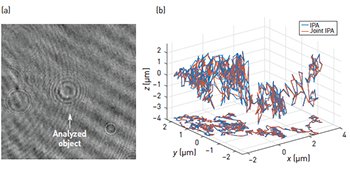 (a) Hologram of a polystyrene colloidal particle of 1 μm of diameter. (b) Brownian trajectory reconstructed using our joint IP reconstruction method.
(a) Hologram of a polystyrene colloidal particle of 1 μm of diameter. (b) Brownian trajectory reconstructed using our joint IP reconstruction method.
The 3-D imaging and reconstruction of volumetric samples holds particular interest in various fields of experimental physics and biomedical imaging. A method of choice among available techniques is digital holography, which consists of a 3-D time-resolved quantitative imaging system. Digital holography aims at recording, on a lensless imaging sensor, the interferences between the light field diffracted, reflected or scattered by an object and a reference beam. Hologram reconstruction often involves calculating the light backpropagation to the planes in which the objects are located.1
Instead of transforming the acquired hologram through light-backpropagation strategies, which are prone to aliases and twin-image noise, we have suggested treating the hologram reconstruction as an inverse problem (IP). IP reconstruction has been shown to give more accurate results than classical reconstruction methods2 and to be optimal in certain experimental configurations.3
To further enhance the reconstruction accuracy while keeping an affordable experimental configuration, we have recently proposed combining IP reconstruction with pixel superresolution, by exploiting information redundancy in sequences of video holograms.4 With this approach, object parameters that remain constant in the sequence—for example, the size of the object—are jointly optimized, which leads to an improvement higher than the square root of the number of holograms.
This approach has been successfully applied for tracking colloidal particles undergoing Brownian motion with a costeffective in-line microscopy experimental arrangement.5 In the example shown here, a colloidal particle is tracked along a sequence of 1,000 holograms, leading to the 3-D trajectory depicted. Statistical analysis of the acquired data makes it possible to assess the reconstruction’s accuracy. The colloidal particle is located within 17×17×60 nm3, with a standard error of less than 0.2 percent on the colloidal particle radius estimation.
These encouraging results pave the way to cost-effective, highly accurate imaging devices for which high-end optical elements are replaced by optimal data processing. Moreover, these approaches are not limited to holography, but can be extended to all imaging techniques relying on a known image formation model.
Researchers
N. Verrier and C. Fournier, Université de Saint-Etienne Jean Monnet, Saint-Etienne, France
References
1. U. Schnars et al. Meas. Sci. Technol. 13, R85 (2002).
2. F. Soulez et al. J. Opt. Soc. Am. A 24, 1164 (2007).
3. K. Mortensen. Nat. Methods 7, 377 (2010).
4. N. Verrier et al. Opt. Lett. 40, 217 (2015).
5. N. Verrier et al. Appl. Opt. 54, 4996 (2015).
